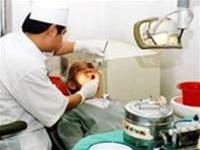Osteomyelitis of the Jaw: A Common Condition with Potentially Serious Complications
 |
| Dental examination at Huong Khe District Hospital – Ha Tinh (Photo: TTO) |
The jawbone can become inflamed due to various causes, including bacterial infections, trauma, or the improper eruption of wisdom teeth. This inflammation may arise locally or be a result of bacteria spreading through the bloodstream from other infected areas or systemic infections. The jawbone is more prone to inflammation than other bones due to its association with the tooth roots, which can become infected from dental procedures like tooth extractions, replacements, or the emergence of wisdom teeth.
Symptoms of Osteomyelitis of the Jaw: Patients typically experience pain in the area around the affected tooth, which is continuous and worsens at night. They may also have a high fever (39-40°C), fatigue, and weakness. If left untreated, the pain can spread throughout the jaw and face, leading to severe discomfort that is unresponsive to analgesics. The jaw may feel rigid, breath may have a foul odor, saliva production may increase, and the lips may protrude. Patients often present with swelling and deformity on one side of the face, with hot, reddened skin, and the affected teeth may become loose.
The lower jawbone is denser than the upper jawbone and is positioned lower, which can lead to the accumulation of fluids and infectious secretions. Additionally, the thick bone cortex makes it more challenging to expel waste products, and the vascular supply is sparser compared to the upper jaw. Therefore, inflammation is more frequently observed in the lower jaw.
Stages of Osteomyelitis of the Jaw
Acute Congestion Stage: Blood vessels dilate, leading to blood accumulation in the marrow, and inflammatory exudate appears. Early treatment during this stage can result in recovery.
Pus Formation Stage: Many blood vessels become obstructed, and infected thrombi lead to abscesses forming within the bone, resulting in necrosis of the marrow. Small pus pockets within the bone expand, destroying the periosteum and affecting the soft tissues surrounding the jaw. Due to vessel obstruction, necrosis and bone resorption occur, resulting in necrotic bone. When pus escapes to the bone surface, the periosteum may separate. If a large area of necrotic bone exists, it may lead to pathologic fractures. The pus formation and necrotic bone stages can manifest as bone fistulas through the skin or mucosa, or in severe cases, lead to septicemia.
Bone Regeneration Stage: Approximately 15 days after the inflammatory process, there will be a response from the periosteum, leading to new bone deposition and proliferation of connective tissue. Occasionally, rapid proliferation may result in the formation of pseudo-tumors.
Common complications include widespread infection leading to temporomandibular joint arthritis, which may result in jaw stiffness, muscle inflammation, peri-jaw abscesses, purulent infections, septicemia, pathologic fractures, and deformities or atrophy of the jawbone.
To effectively prevent this condition, individuals should maintain daily oral hygiene, brushing their teeth at least twice a day after meals and using antibacterial mouthwash. Regular dental check-ups and professional cleaning every six months are recommended.
For children undergoing tooth replacement and elderly individuals with tooth loss, oral hygiene becomes even more critical. Those with dental caries, gingivitis, or wisdom teeth emergence should not only focus on hygiene but also seek consultations from dental specialists for the best treatment guidance, preventing unfortunate complications.


















































